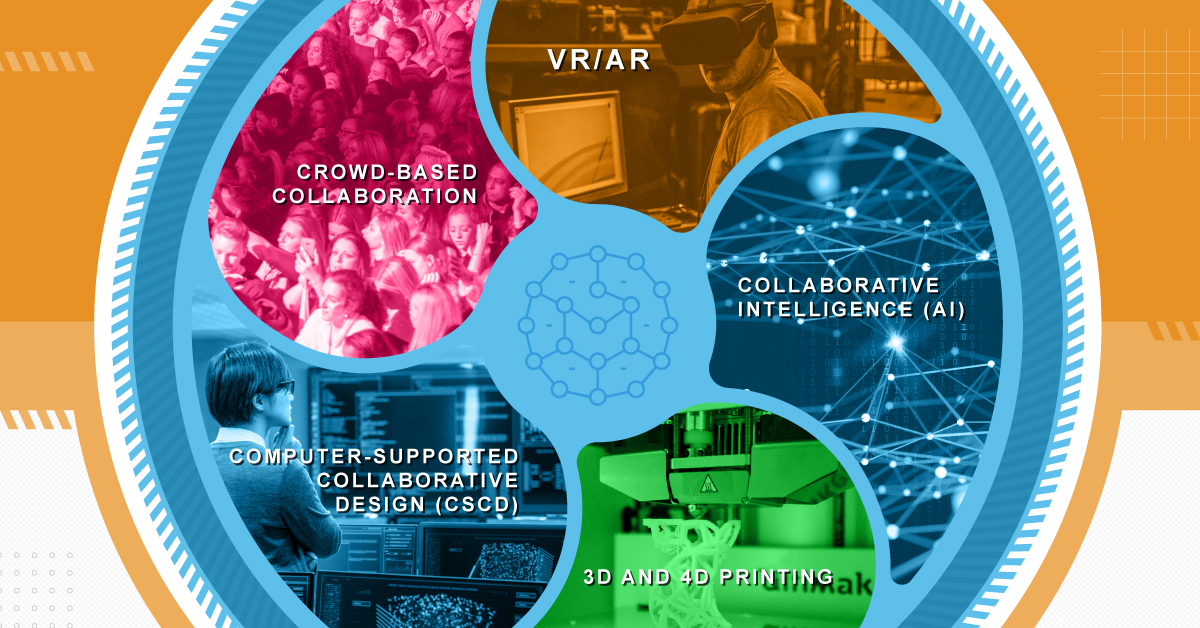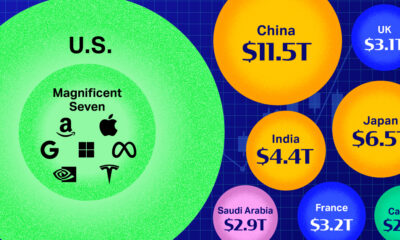Technology
The Future of Collaboration in the Artificial Intelligence Era

The Future of Collaboration in the Artificial Intelligence Era
How humans collaborate with one another has been closely linked to technological progress.
Before the invention of the telephone, we had to be in the same room to communicate in real-time – and prior to the internet, we had to be in the same building to share our designs, new ideas, or other documents.
Collaboration has always been a moving target, and in modern times we shouldn’t be surprised that new technological innovations are again shifting how humans work and coordinate together.
The New Collaboration Cycle
Today’s infographic comes to us from Schneider Electric, and it shows that humans are no longer making things using a linear approach.
Instead, modern collaboration is a cyclical process with no defined start or end points – and it often involves more users and stakeholders, continuous access, and an increasingly decentralized workforce.
The 24/7 Knowledge Factory
All around the world, the way that teams work together is changing.
Instead of always being centralized at a local level, teams are adding talent from around the world who bring diverse perspectives and new ideas to the table.
The modern organization never sleeps – it has people from different countries, time zones, and cultures all working together to create new designs or products simultaneously.
Collaboration on projects is happening in real-time, at all times of the day, and this has several benefits. It brings together a broader range of skills and perspectives, makes teams more customer-centric, reduces errors and wasted money, and enhances both decision-making and product development cycles.
Working Together is Changing
How are teams collaborating 24/7 in real-time from locations around the world?
VR/AR
Designers, engineers, and other team members can collaborate in parallel, using mixed reality as a common medium.
Collaborative Intelligence (AI)
Multi-agent, distributed systems where each agent, human or machine, is uniquely positioned, with autonomy to contribute to a problem-solving network.
Advanced Modelling (3D and 4D printing)
Design and manufacturing can be integrated seamlessly, even to customize individual items. 4d printing (fourth dimension: movement) is a new frontier where printed objects adapt to various circumstances.
Crowd-based Collaboration
Design is no longer siloed and can be democratized between different stakeholders. Further, teams can work simultaneously from all over the world.
Computer Supported Collaborative Design (CSCD)
The synchronous sharing of information and interaction with ideas, in an AI-driven, data-intensive environment. Here, problem solving, data and service “agents” support, or replace, labor intensive work and possibly the human traits of intuition and decisi, as well.n making.
The Next Wave
How humans work together is changing, but also shifting is how humans and AI will collaborate together.
The new technological landscape creates many questions and uncertainties for companies today:
- Will new “collaborative” technologies really change how we engage, and innovate with, our colleagues?
- Will a hyper-networked, always-engaged global collaborative environment create “too many cooks in the kitchen”?
- With more opportunity to get involved in processes, how does the role of the end-customer change?
- Will traditional design and implementation switch to being more service-based, as time goes on?
Technology
Ranked: Semiconductor Companies by Industry Revenue Share
Nvidia is coming for Intel’s crown. Samsung is losing ground. AI is transforming the space. We break down revenue for semiconductor companies.
Semiconductor Companies by Industry Revenue Share
This was originally posted on our Voronoi app. Download the app for free on Apple or Android and discover incredible data-driven charts from a variety of trusted sources.
Did you know that some computer chips are now retailing for the price of a new BMW?
As computers invade nearly every sphere of life, so too have the chips that power them, raising the revenues of the businesses dedicated to designing them.
But how did various chipmakers measure against each other last year?
We rank the biggest semiconductor companies by their percentage share of the industry’s revenues in 2023, using data from Omdia research.
Which Chip Company Made the Most Money in 2023?
Market leader and industry-defining veteran Intel still holds the crown for the most revenue in the sector, crossing $50 billion in 2023, or 10% of the broader industry’s topline.
All is not well at Intel, however, with the company’s stock price down over 20% year-to-date after it revealed billion-dollar losses in its foundry business.
| Rank | Company | 2023 Revenue | % of Industry Revenue |
|---|---|---|---|
| 1 | Intel | $51B | 9.4% |
| 2 | NVIDIA | $49B | 9.0% |
| 3 | Samsung Electronics | $44B | 8.1% |
| 4 | Qualcomm | $31B | 5.7% |
| 5 | Broadcom | $28B | 5.2% |
| 6 | SK Hynix | $24B | 4.4% |
| 7 | AMD | $22B | 4.1% |
| 8 | Apple | $19B | 3.4% |
| 9 | Infineon Tech | $17B | 3.2% |
| 10 | STMicroelectronics | $17B | 3.2% |
| 11 | Texas Instruments | $17B | 3.1% |
| 12 | Micron Technology | $16B | 2.9% |
| 13 | MediaTek | $14B | 2.6% |
| 14 | NXP | $13B | 2.4% |
| 15 | Analog Devices | $12B | 2.2% |
| 16 | Renesas Electronics Corporation | $11B | 1.9% |
| 17 | Sony Semiconductor Solutions Corporation | $10B | 1.9% |
| 18 | Microchip Technology | $8B | 1.5% |
| 19 | Onsemi | $8B | 1.4% |
| 20 | KIOXIA Corporation | $7B | 1.3% |
| N/A | Others | $126B | 23.2% |
| N/A | Total | $545B | 100% |
Note: Figures are rounded. Totals and percentages may not sum to 100.
Meanwhile, Nvidia is very close to overtaking Intel, after declaring $49 billion of topline revenue for 2023. This is more than double its 2022 revenue ($21 billion), increasing its share of industry revenues to 9%.
Nvidia’s meteoric rise has gotten a huge thumbs-up from investors. It became a trillion dollar stock last year, and broke the single-day gain record for market capitalization this year.
Other chipmakers haven’t been as successful. Out of the top 20 semiconductor companies by revenue, 12 did not match their 2022 revenues, including big names like Intel, Samsung, and AMD.
The Many Different Types of Chipmakers
All of these companies may belong to the same industry, but they don’t focus on the same niche.
According to Investopedia, there are four major types of chips, depending on their functionality: microprocessors, memory chips, standard chips, and complex systems on a chip.
Nvidia’s core business was once GPUs for computers (graphics processing units), but in recent years this has drastically shifted towards microprocessors for analytics and AI.
These specialized chips seem to be where the majority of growth is occurring within the sector. For example, companies that are largely in the memory segment—Samsung, SK Hynix, and Micron Technology—saw peak revenues in the mid-2010s.
-

 Mining2 weeks ago
Mining2 weeks agoCharted: The Value Gap Between the Gold Price and Gold Miners
-

 Real Estate1 week ago
Real Estate1 week agoRanked: The Most Valuable Housing Markets in America
-

 Business1 week ago
Business1 week agoCharted: Big Four Market Share by S&P 500 Audits
-

 AI1 week ago
AI1 week agoThe Stock Performance of U.S. Chipmakers So Far in 2024
-

 Misc1 week ago
Misc1 week agoAlmost Every EV Stock is Down After Q1 2024
-

 Money2 weeks ago
Money2 weeks agoWhere Does One U.S. Tax Dollar Go?
-

 Green2 weeks ago
Green2 weeks agoRanked: Top Countries by Total Forest Loss Since 2001
-

 Real Estate2 weeks ago
Real Estate2 weeks agoVisualizing America’s Shortage of Affordable Homes














